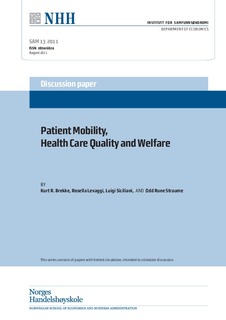Patient Mobility, Health Care Quality and Welfare
Working paper
Permanent lenke
http://hdl.handle.net/11250/163368Utgivelsesdato
2011-08Metadata
Vis full innførselSamlinger
- Discussion papers (SAM) [657]
Sammendrag
Patient mobility is a key issue in the EU who recently passed a new law on patients right to
EU-wide provider choice. In this paper we use a Hotelling model with two regions that differ in
technology to study the impact of patient mobility on health care quality, health care nancing
and welfare. A decentralised solution without patient mobility leads to too low (high) quality and
too few (many) patients being treated in the high-skill (low-skill) region. A centralised solution
with patient mobility implements the rst best, but the low-skill region would not be willing to
transfer authority as its welfare is lower than without mobility. In a decentralised solution, the
effects of patient mobility depend on the transfer payment. If the payment is below marginal
cost, mobility leads to a race-to-the-bottom in quality and lower welfare in both regions. If the
payment is equal to marginal cost, quality and welfare remain unchanged in the high-skill region,
but the low-skill region bene ts. For a socially optimal payment, which is higher than marginal
cost, quality levels in the two regions are closer to (but not at) the rst best, but welfare is lower
in the low-skill region. Thus, patient mobility can have adverse effects on quality provision and
welfare unless an appropriate transfer payment scheme is implemented.
